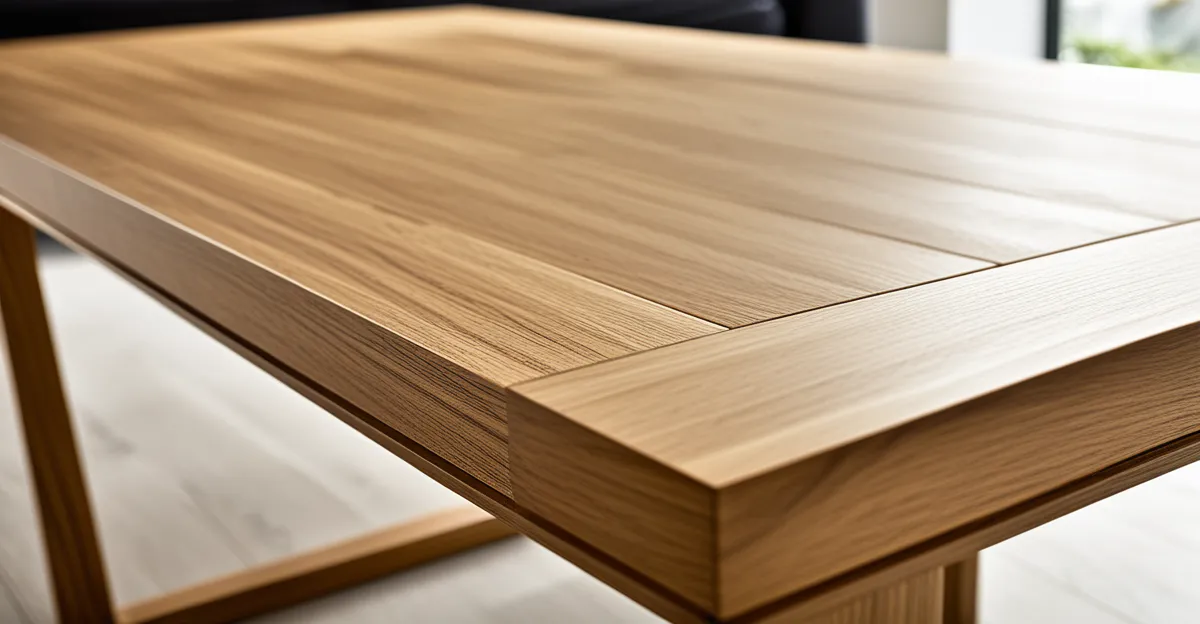Latest Sustainable Furniture Materials in the UK
The surge in sustainable furniture UK reflects a strong shift towards using eco-friendly materials that reduce environmental impact. Innovations in recycled and reclaimed resources are central. Furniture makers increasingly use recycled metals, plastics, and reclaimed wood, transforming waste into stylish, durable pieces. These materials not only minimize landfill waste but also lower the carbon footprint associated with raw material extraction.
Another key trend is the rising use of low-impact certified woods such as FSC or PEFC certified timber, ensuring responsible forest management. Bamboo, valued for its rapid growth and renewability, is gaining popularity as an alternative to traditional hardwoods. Its strength and versatility complement modern furniture styles while supporting green home trends.
Have you seen this : How Can Home Automation Enhance Your Daily Life in the UK?
Plant-based fabrics like organic cotton, hemp, and linen are also on the rise, offering renewable and biodegradable options for upholstery. Coupled with non-toxic finishes—water-based varnishes and natural oils—these materials promote healthier indoor air quality. By combining these elements, UK manufacturers deliver furniture that aligns with sustainability goals without compromising design or durability.
Latest Sustainable Furniture Materials in the UK
The surge in sustainable furniture UK initiatives highlights innovative use of eco-friendly materials that reduce environmental impact. A major development involves recycled and reclaimed resources, transforming discarded wood, metal, and plastic into stylish, durable furniture. This approach not only diverts waste from landfills but also preserves natural resources.
Topic to read : What are Innovative Approaches to Enhance Your UK Home Living Experience?
Certified low-impact woods, such as FSC and PEFC certified hardwoods, are increasingly popular. These woods come from responsibly managed forests, meeting strict ecological and social standards. Additionally, bamboo—a fast-growing, renewable plant—has gained traction for its strength and minimal cultivation footprint.
Plant-based fabrics, including organic cotton and hemp, along with non-toxic finishes like water-based stains and natural oils, contribute to safer indoor environments while aligning with green home trends. These materials avoid harmful chemicals typically found in conventional finishes.
Together, such innovations in materials not only demonstrate a commitment to sustainability but also offer consumers practical, attractive options for eco-conscious living in the UK furniture landscape.
Design Trends Shaping Sustainable UK Furniture
Sustainable furniture design increasingly embraces circular design principles, which focus on reuse, repair, and recycling to extend product life cycles. This approach minimizes waste by creating pieces meant to be disassembled or updated rather than discarded. In the UK, modular components are gaining traction, allowing consumers to customize and adapt furniture over time, aligning perfectly with green home trends.
Minimalist furniture UK styles complement sustainability by prioritizing functional simplicity and reducing excess materials. Clean lines, fewer embellishments, and efficient use of raw materials are signatures of minimalist design that, combined with eco-friendly materials, yield environmentally responsible products with lasting appeal.
Aesthetic choices reflect natural influences too. Earthy tones, subtle wood grains, and natural finishes highlight the origin of materials, enhancing home interiors with warm, organic textures. Incorporating biophilic elements—designs inspired by nature—boosts wellbeing while reinforcing the sustainability message.
Together, circular design, minimalist furniture UK, and nature-driven aesthetics are shaping an exciting future for eco-conscious living spaces, marrying function, beauty, and environmental responsibility seamlessly.
Latest Sustainable Furniture Materials in the UK
Eco-friendly materials are at the heart of the sustainable furniture UK movement, shaping how manufacturers innovate today. Recycled and reclaimed materials lead this transformation by diverting waste from landfills and reducing dependency on virgin resources. For instance, reused metal and plastic components decrease energy-intensive production, while reclaimed wood adds unique character and durability.
The emphasis on low-impact certified woods such as FSC and PEFC ensures sustainable forestry practices, addressing both environmental protection and social responsibility. Bamboo’s rapid regrowth rate and minimal water needs further bolster its appeal as a top choice for sustainable furniture UK. This material combines natural strength with a low ecological footprint, aligning well with green home trends.
Plant-based fabrics also play a critical role. Organic cotton, hemp, and linen deliver biodegradable and renewable upholstery solutions, mitigating the chemical concerns linked to conventional textiles. Paired with non-toxic finishes—like water-based varnishes and natural oils—these materials help maintain healthy indoor air quality without compromising style or longevity.
Together, these innovations define the evolving landscape of sustainable furniture UK, making eco-friendly materials more accessible and appealing than ever before.
Leading Sustainable Furniture Brands in the UK
Exploring UK sustainable furniture brands reveals a strong commitment to transparency and ethical practices. Leading eco-conscious furniture companies often pursue certifications such as FSC, PEFC, or Cradle to Cradle, ensuring responsible sourcing and production. These certifications verify adherence to environmental and social standards, giving consumers confidence in their choices.
Many standout brands emphasize transparent supply chains, openly sharing information about material origins, manufacturing processes, and labor conditions. This transparency supports informed decision-making and fosters trust, key aspects in advancing sustainability within the UK furniture market.
Collaborative initiatives among these companies are increasingly common, targeting circularity and waste reduction. Partnerships often focus on design for disassembly, take-back programs, or recycling schemes, illustrating a holistic approach to sustainability. By combining innovation with accountability, UK sustainable furniture brands set benchmarks for environmental responsibility.
Consumers interested in sustainable furniture UK should consider these brands’ commitments carefully, as they exemplify how ethical standards and quality design can coexist. This leadership not only fuels the growth of eco-friendly materials but also aligns perfectly with evolving green home trends.
Latest Sustainable Furniture Materials in the UK
The growth of sustainable furniture UK is driven by innovations in eco-friendly materials that support green home trends. Recycled and reclaimed materials remain at the forefront, transforming waste wood, metals, and plastics into beautiful, functional furniture. This process reduces landfill pressure while conserving natural resources and lowering manufacturing emissions.
Low-impact certified woods, particularly FSC and PEFC options, are increasingly preferred. These certifications confirm sustainable forest management, ensuring timber harvest supports biodiversity and local communities. Bamboo, with its rapid growth and minimal water requirements, continues to rise as a renewable alternative, prized for durability and versatility.
Plant-based fabrics such as organic cotton, hemp, and linen are expanding upholstery choices. These textiles offer biodegradability and less chemical input, meeting demands for healthier indoor environments. Non-toxic finishes, including water-based varnishes and natural oils, complement these materials by protecting furniture without contaminating air quality.
Together, these developments in recycled components, certified woods, bamboo, and plant fabrics define the evolving material landscape. Consumers embracing sustainable furniture UK benefit from options that marry environmental responsibility with modern design and long-lasting quality.
Latest Sustainable Furniture Materials in the UK
The surge in sustainable furniture UK innovation centers on advanced use of eco-friendly materials that align with evolving green home trends. A key driver is the refinement of recycled and reclaimed materials, where discarded metals, plastics, and wood are transformed into durable, stylish furniture. This reduces landfill waste and decreases the need for new raw materials, supporting circular resource use.
Low-impact certified woods such as FSC and PEFC remain popular choices for sustainable furniture UK, ensuring responsible forest harvesting. Bamboo’s cultivation is rapidly increasing due to its fast growth, renewable nature, and strength, making it a standout material. Its low water requirements and carbon sequestration capabilities further bolster its eco credentials.
Plant-based fabrics are growing in prominence, especially organic cotton, hemp, and linen, which offer renewable, biodegradable options for upholstery and soft furnishings. These fabrics pair effectively with non-toxic finishes like water-based varnishes and natural oils, which enhance indoor air quality. This combination of materials fulfills the sustainability demands of consumers while keeping style and durability intact. Collectively, these material choices represent actionable steps toward greener, healthier homes.
Latest Sustainable Furniture Materials in the UK
Innovations in sustainable furniture UK prominently feature eco-friendly materials like recycled and reclaimed resources. These materials reduce waste by upcycling discarded wood, plastics, and metals into durable furniture, effectively lowering environmental footprints. Such practices align closely with current green home trends, encouraging responsible consumer choices.
An increasing focus is also on low-impact certified woods, including FSC and PEFC certified timber. These certifications guarantee wood comes from sustainably managed forests, balancing ecological preservation with economic viability. Bamboo’s rapid renewability and strength make it a standout alternative, prized within sustainable furniture UK for its minimal resource use and versatility.
Meanwhile, plant-based fabrics such as organic cotton, hemp, and linen are gaining traction. These textiles provide biodegradable, renewable upholstery options that support healthier living spaces by avoiding harmful chemicals. When combined with non-toxic finishes—like water-based varnishes and natural oils—they enhance indoor air quality, reinforcing green home trends.
Together, these material advancements position UK furniture as both environmentally responsible and stylistically modern, empowering consumers to embrace sustainable living confidently.
Latest Sustainable Furniture Materials in the UK
The rise of sustainable furniture UK is driven by cutting-edge use of eco-friendly materials that support current green home trends. Recycled and reclaimed resources remain crucial, turning waste wood, metals, and plastics into furniture that reduces landfill burden while conserving resources. These materials also lower the energy needed for production, facilitating a circular economy approach.
Low-impact certified woods like FSC and PEFC-certified timber are increasingly used due to their responsible forest management credentials, ensuring sustainability and biodiversity protection. Bamboo’s popularity grows as well, prized for its rapid growth and minimal water requirements, which significantly decrease environmental impact compared to traditional hardwoods.
Plant-based fabrics such as organic cotton, hemp, and linen are expanding upholstery options. These materials are biodegradable, renewable, and free from harmful chemicals. Combined with non-toxic finishes like water-based varnishes and natural oils, they contribute to healthier indoor air quality while preserving design integrity.
Together, these innovations in recycled components, certified woods, bamboo, and natural fabrics provide practical, sustainable solutions for eco-conscious consumers pursuing stylish, durable, and environmentally responsible furniture in the UK.
Latest Sustainable Furniture Materials in the UK
Advancements in sustainable furniture UK largely revolve around the innovative use of eco-friendly materials that mirror current green home trends. A primary focus is on recycled and reclaimed materials—discarded wood, metals, and plastics are repurposed, reducing landfill waste and lowering demand for virgin resources. This practice not only supports sustainability but also creates unique, character-rich furniture pieces.
Simultaneously, the use of low-impact certified woods such as FSC and PEFC certified timber continues to gain momentum. These certifications confirm that the wood comes from responsibly managed forests, balancing ecosystem health with economic needs. Bamboo’s rapid regrowth and minimal water requirement make it a standout alternative, prized for strength and environmental benefits, resonating with eco-conscious UK consumers.
In upholstery, plant-based fabrics like organic cotton, hemp, and linen are increasingly preferred. These materials offer natural biodegradability and reduce harmful chemical use. When combined with non-toxic finishes—including water-based varnishes and natural oils—they foster healthier indoor environments. These collective advances in materials illustrate how sustainable furniture UK aligns style, function, and ecological responsibility effectively.





